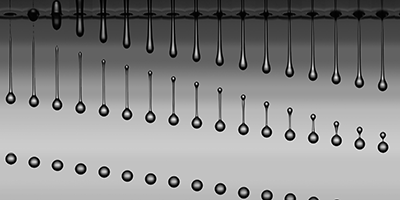Droplets Caught at High Speed
Inkjet printers are the most common type of printers in the world. One of the advantages of inkjet printers is the highly reproducible size of the droplets that are a billion times smaller than a teaspoon. For this reason, inkjet technology goes beyond just paper documents, with researchers developing methods to print electronic circuits with conductive inks and artificial organs with cells.
Scientists model inkjet droplets using numerical simulations. However, these models are difficult to experimentally verify, since the picoliter-sized droplets are moving at several meters per second—too fast for most microscopic imaging methods. A new imaging technique, presented in the inaugural issue of Physical Review Applied, is able to record this droplet formation with unprecedented spatial and time resolution. An analysis of the fluid motion matches numerical simulations and may be used to optimize inkjet printer performance.
The pictures taken by Detlef Lohse of the University of Twente, Netherlands, and his colleagues show how silicone oil droplets change shape from slender drips to round balls. The team uses a laser-induced flash ( nanoseconds long) to illuminate the droplets as they emerge from a commercial inkjet printer head. The transmitted light is magnified by a microscope before being recorded by a high-speed camera. The team measured changes in droplet shape between frames separated by nanoseconds. From this, they computed the velocity of fluid at different points inside the droplets and found good agreement with numerical simulations. The images can help improve printer precision by revealing the cause of small, unwanted “satellite” droplets that sometimes form with the main droplet. – Michael Schirber
Correction (28 February 2014): Paragraph 3, sentence 1, “silicon” changed to “silicone.”





